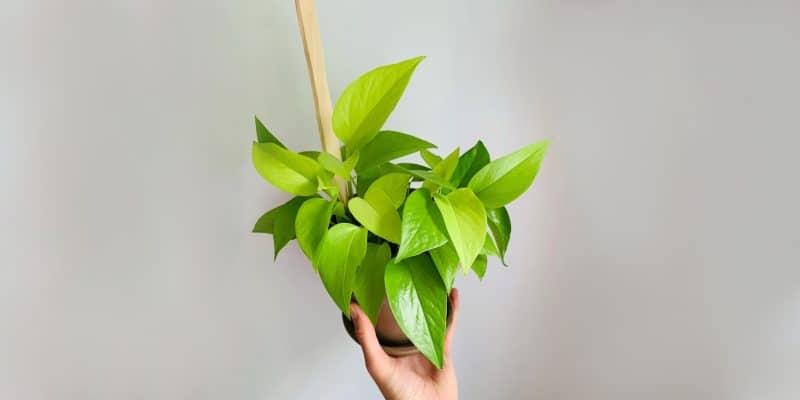If a corner of your house is glowing with a vibrant, electric green, don’t worry — it’s just a Neon Pothos doing its thing!
This fun and versatile pothos plant brings a touch of tropical flair to your home. It’s incredibly low-maintenance too.
We’ll cover everything you need to know about Neon Pothos care, from its origins and care to troubleshooting potential issues. Stay tuned for all the tips and tricks for keeping your Neon Pothos happy, healthy, and — most importantly — glowing.
Table of Contents
Neon Pothos Plant Care Guide
History, Habitat, and Characteristics
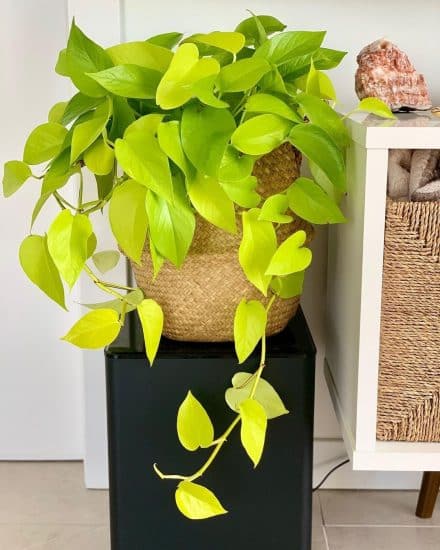
Neon Pothos (Epipremnum aureum ‘Neon’) is a vibrant and charming indoor companion native to the Society Islands of French Polynesia. Its notable feature is its neon-green foliage, as well as the heart-shaped leaves typical of not just neon pothos, but all pothos plants!
This vining plant is well-known for being low-maintenance, and it will stun as a hanging plant or sat atop a tall plant stand or piece of furniture. If you train it (not quite like a dog), Neon Pothos grow up a trellis or moss pole, too.
In fact, the stems of a mature neon pothos plant can grow as long as 20 feet.
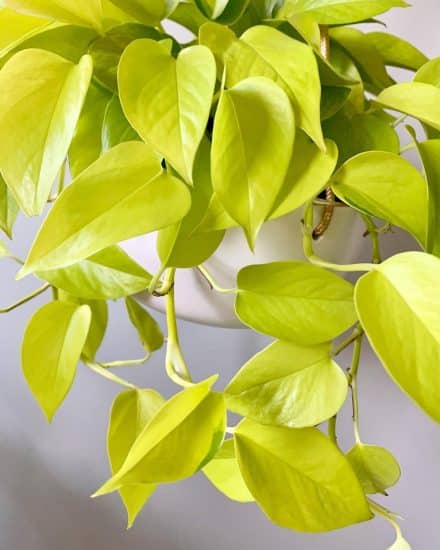
Although it’s sometimes confused with jade pothos, the neon plant has lighter leaves, almost yellow in comparison.
Fun fact: Neon Pothos isn’t just a pretty glowing face. NASA studies have shown that it’s a champ at purifying the air by removing common pollutants, such as benzene and formaldehyde.
Light
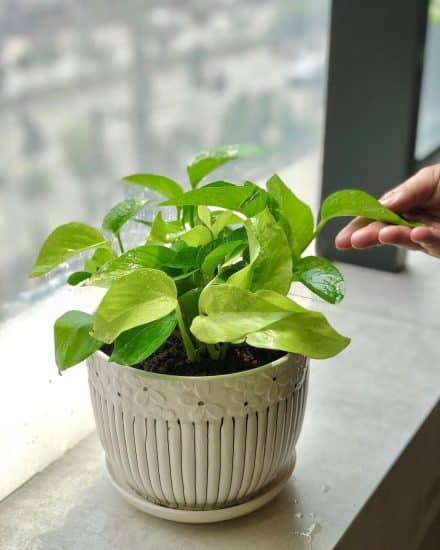
Like the Jessenia Pothos, Neon Pothos craves more light than golden pothos and other pothos varieties — but indirect light is this tropical plant’s best friend. Near an east- or west-facing window should be an ideal spot for your Neon Pothos, but avoid windows that get too much direct sun.
Direct sun will scorch its delicate leaves, leaving them looking less than fabulous. Keep an eye out for yellow, brown, or crispy leaves. These are signs that your neon pothos is getting too much light.
You can move your plant a few feet to the side of a bright window or use a sheer curtain to diffuse direct light.
Even though Neon Pothos light requirements are versatile, it does need a healthy dose. They can tolerate low light, but Neon Pothos grow faster with more vibrant foliage in brighter light.
If your plant starts sporting pale leaves, or leaves that are smaller than they should be, it’s time to find a brighter spot with enough light.
Lighting tips:
- Place your Neon Pothos in a well-lit area with indirect bright light.
- Protect your Neon Pothos plant from direct sun.
- To protect your Neon Pothos from excessive sunlight, use a sheer curtain or relocate the plant away from direct rays.
Water
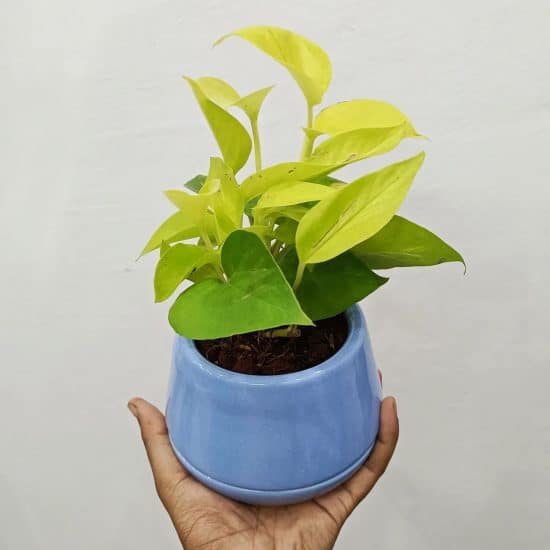
Like any pothos plant, it’s best to let the soil dry out before you water Neon Pothos again. Use your finger to gauge the dryness of your plant’s soil, and water when the top few inches are dry. Neon Pothos plants will droop a bit when they’re thirsty, but they’ll perk right back up after a thorough watering.
You’ll probably notice that the brighter light your pothos plant gets, the more often you have to water it. Be mindful of giving your pothos too much water, especially if it’s in a low-light location.
You should also cut down on watering during the winter, when most plant growth slows. You can probably go weeks without watering your pothos plants during the winter.
Too much water can cause yellowing leaves all over the plant, as well as mushy stems and soggy soil. If brown leaf tips follow, accompanied by small brown and black spots on the leaves, root rot is likely the culprit.
Cut back on your Neon Pothos watering and give the soil a chance to dry out. Extreme cases will require repotting.
Watering tips:
- Check the soil’s moisture level by poking your finger about an inch or two deep. If it feels dry, go ahead and water.
- When watering, saturate the soil thoroughly, ensuring excess water drains from the pot’s bottom through a drainage hole.
- Be mindful of your Neon Pothos location — factors like light and humidity could impact its water requirements.
- During winter or slower growth periods, reduce your Neon Pothos watering frequency to meet your plant’s changing needs.
Temperature and Humidity
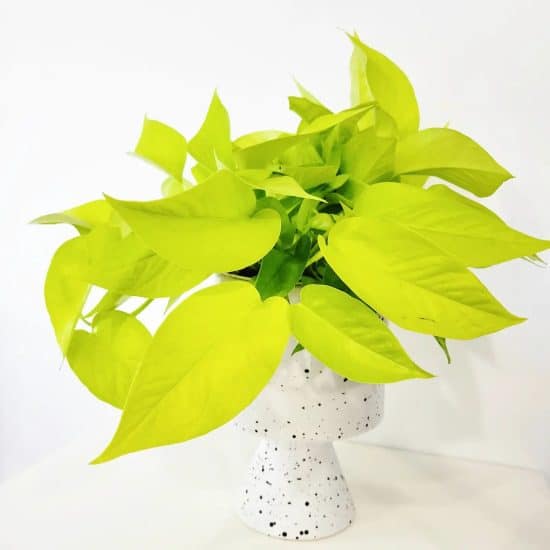
It’s crucial to provide your Neon Pothos with a warm temperature between 65°F and 85°F (18°-30°C), and no lower than 60 degrees (15°C) at night.
Although Neon Pothos temperature tolerance reaches down to 50°F, it’s best to avoid prolonged exposure to these lower temperatures. Consistent temperatures will help your pothos flourish.
If your Neon Pothos experiences temperatures that are too high, the leaves may wilt and turn yellow. On the other hand (stem?), low temperatures can cause leaf drop and stunted growth.
To keep your Neon Pothos plant healthy, avoid placing it near heat sources, such as radiators, or near drafty windows during the winter. Be mindful of air conditioning vents during summer as well.
As a tropical plant, Neon Pothos appreciates average household humidity levels around 40%-60%. Signs of inadequate humidity include drooping, yellowing leaves or crispy, brown tips.
If you notice these symptoms in your Neon Pothos leaves, it’s time to adjust the humidity.
Tips for increasing humidity:
- Place your potted plant on a pebble tray filled with water.
- Run a humidifier nearby for a few hours each day.
- Group your Neon Pothos plant with other houseplants to increase humidity through transpiration.
If you employ any of these measures in your Neon Pothos care routine, don’t overdo it. Excessive humidity can also cause trouble for your Neon Pothoss. Keep an eye on your Neon Pothos plant to make sure it’s not getting too much humidity.
Excess humidity can lead to plant diseases, including fungus, which can spread to nearby plants. If you find that your Neon Pothos’ leaves are turning black, the air around it may be too moist.
Soil and Planting
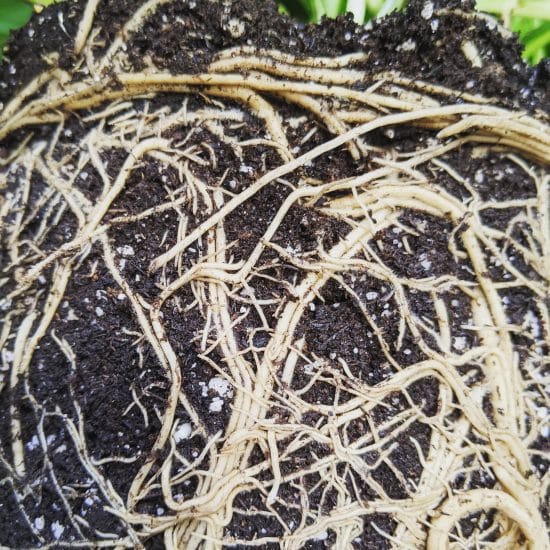
For the perfect well-drained Neon Pothos soil mix, combine equal parts soil, compost, and perlite.
To maintain moisture, you can also add coconut coir (an eco-friendly alternative to peat moss). This fluffy, well-draining soil mixture will encourage proper root development and effectively maintain soil moisture, keeping your Neon Pothos healthy indoors or outdoors.
Although Neon Pothos grows 12 to 18 inches per month, it doesn’t need frequent repotting. When it does, springtime is the best season for this task. You can tell it’s ready if the roots are growing around the outside of the soil mix.
Choose a container only a few inches larger than its current pot and ensure it has proper drainage holes.
When repotting your Neon Pothos, be gentle with the roots, and avoid packing the potting soil too tightly around the root ball. This will help maintain oxygen flow to the roots and reduce the risk of root rot.
Fertilizing
Signs of poor soil may indicate that your Neon Pothos is getting insufficient nutrients. Slow growth and yellowing leaves might mean that it needs to be repotted or needs its watering adjusted.
If these elements are on point, try adding a balanced houseplant fertilizer. Do this regularly during spring and summer, but not during the dormant winter months.
Just be careful with adding fertilizer and follow the recommended dose. Signs of too much fertilizer in Neon Pothos include burnt leaf tips, slow growth, or a general decline in the plant’s health.
To resolve this, flush the pot with water, letting the excess water drain out, and repeat this process a few times. This will remove excess fertilizer salts from the soil.
Propagation
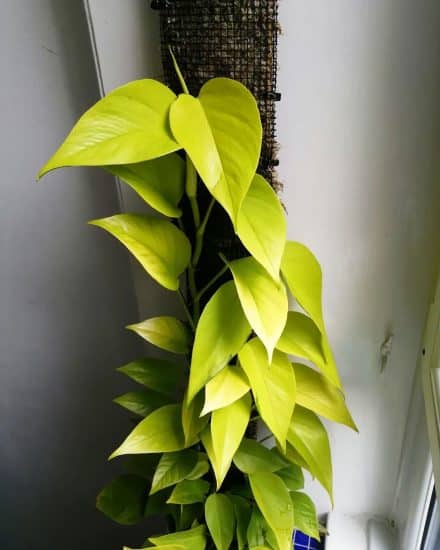
Propagating Neon Pothos is a piece of cake! Just follow these easy steps, you’ll have many new pothos plants in no time. Snipping its stems has the added bonus of making neon pothos bushier, too, since new growth will branch from the cut.
Remember, this variety is a bit more prone to issues, so keep a watchful eye on your cuttings.
Propagating Neon Pothos via stem cuttings in water:
- Pick a winner: Find a healthy stem on your Neon Pothos, about 4-6 inches long, with at least 3 to 5 leaves.
- Give it a trim: Remove the bottom leaf from the stem to keep it out of the water.
- Get the spa ready: Grab a container and fill it with filtered or bottled water (rainwater works too). Gently place your cutting in the water, making sure the leafless nodes are submerged and the leaves are not.
- Set the mood: Place your future Neon Pothos baby in a spot with indirect, bright light and warm temperatures. Change the water every 2-3 days to keep it fresh and clean.
- Watch the magic happen: Once the fresh roots reach about 2 inches long, it’s time for the big move! Transfer your cutting into a container filled with our recommended blend of potting soil.
Common Issues
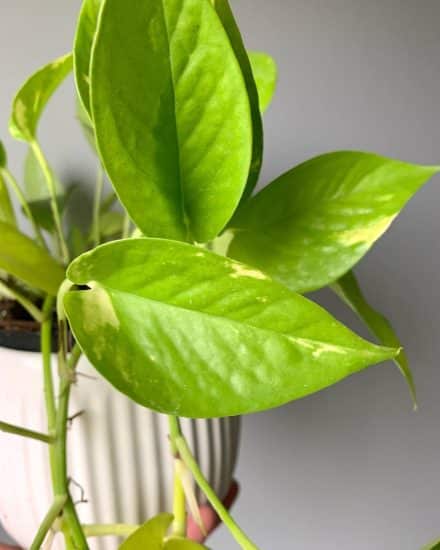
Yellowing Leaves
Yellowing Neon Pothos leaves could be from a number of causes. Most likely it’s due to overwatering or a nutrient deficiency, but it could also indicate the need for a larger pot. To get to the root of the problem (see what I did there?), give your watering routine a once-over and ensure your Neon Pothos is getting the nutrients it needs to thrive.
To help your Epipremnum aureum ‘Neon’ grow bushier and healthier, keep an eye on your watering schedule, allowing the soil to dry out just a touch between waterings. Ensure the soil is never soggy. Make sure your plant isn’t root-bound, and don’t forget to treat it to some well-balanced fertilizer.
Bleached Leaves
This could mean your Neon Pothos isn’t getting the right light, or it’s missing out on some essential nutrients. Assess how much light your Neon Pothos is getting — is it in too much direct sunlight or hiding out in a dim corner?
To bring your Neon Pothos plant back to life, find a spot with bright, indirect light. Direct sunlight can be too harsh for mellow pothos plants. If you move your Neon Pothos outdoors for the spring and summer, keep it under a patio roof or awning.
If you’re not already fertilizing, add a balanced fertilizer to your Neon Pothos care routine, and remember to water appropriately.
Pests and Diseases

Root rot is the most common of the Neon Pothos diseases we see. But it’s relatively easy to avoid and not impossible to recover from.
Moisture Issues
Keeping the soil moist but not too moist is essential for Neon Pothos care, especially when you want these tropical plants to grow faster.
However, too much moisture can lead to problems in Neon Pothos, like phytophthora root rot, a water mold. To prevent this, make sure the soil drains well. Adding perlite, pumice, or LECA can make a big difference in drainage. Remember, don’t overwater! Only give your potted plant a drink when the soil is dry to the touch.
And the cardinal rule of growing houseplants — always have drainage holes when dealing with any potted plant! Without them, your plant will almost certainly get root rot, which can kill it if not treated quickly.
Mealybugs and Spider Mites
Now, let’s talk bugs. Your Neon Pothos plant can sometimes play host to pests like mealybugs and spider mites. They tend to hide quite well in your hanging plant, so early detection is super important before they become a major headache.
Mealybugs look like tiny cotton balls hanging out on leaves and stems. To show ’em who’s boss, pick them off or give the entire plant a good spray of water. Next, use a dish soap solution or neem oil on the affected areas, making sure to cover both the top and bottom of the leaves.
Spider mites are sneaky little critters — they spin webbing on your neon plant, making them hard to spot.
If you see any webbing, immediately give your Neon Pothos a good rinse with a hose or a thorough wipe with a damp cloth soaked in rubbing alcohol. Apply neem oil spray to take care of any remaining mites and their eggs, and reapply every few weeks as needed.
Fungus Gnats
Ah, the dreaded fungus gnat. If you’re a seasoned houseplant collector, you know these guys well. The key to avoiding them is to never overwater, but even if you carefully mete out your plant’s moisture, you can still get an infestation of fungus gnats.
Fungus gnats have two elements you need to address: adults and larvae. The adults, you can catch on sticky, yellow traps, but the larvae are trickier.
First, try scooping out the top 2 inches of soil and discarding it, adding fresh soil. Stubborn infestations will require a complete repotting with all new fresh soil, but it will solve the problem.
Conclusion
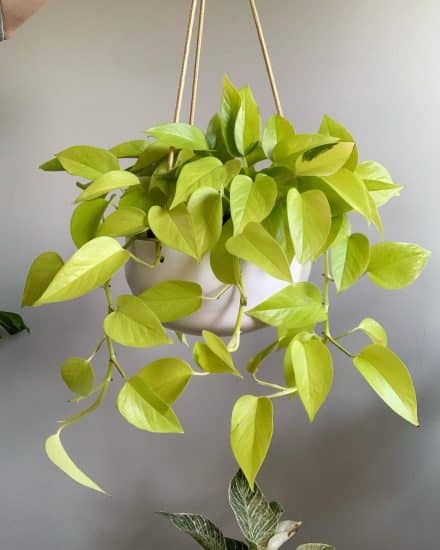
And there you have it — our comprehensive Neon Pothos care guide! Remember, its eye-popping hue definitely isn’t a golden pothos gone radioactive. (Hopefully).
Neon Pothos care summary:
- Choose a bright spot with bright indirect light to help maintain your plant’s electrifying leaf color.
- Create the ideal soil mix by combining equal parts potting soil, compost, and perlite for proper drainage.
- Use a balanced liquid fertilizer regularly during the growing months.
- Ensure a comfortable temperature range of 65-85°F (18-30°C) and 40%-60% humidity.
- Propagate Neon Pothos using stem cuttings in water.
If you found our Neon Pothos tips useful, please share this guide with your fellow plant lovers. And remember, we’re always here to help you with any plant-related questions.
Happy growing!
FAQ
Is Neon Pothos easy to care for?
Absolutely. Neon Pothos plants are splendidly uncomplicated and low-maintenance, making them a top pick for both newbie gardeners and seasoned plant parents. Just remember to give them proper lighting (bright indirect light is their BFF), water them moderately, and watch them flourish.
Is Neon Pothos rare?
Neon pothos isn’t exactly an elusive unicorn, but it’s a touch more uncommon than some of its more well-known pothos siblings, such as the golden variety or marble queen pothos. Its neon-green heart-shaped leaves make it a stand-out star among indoor plants.

